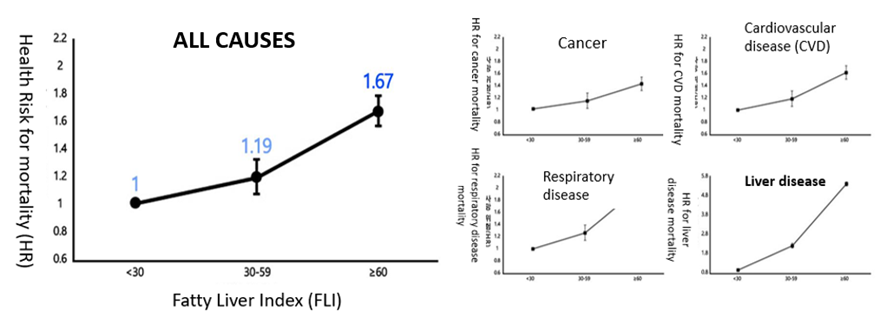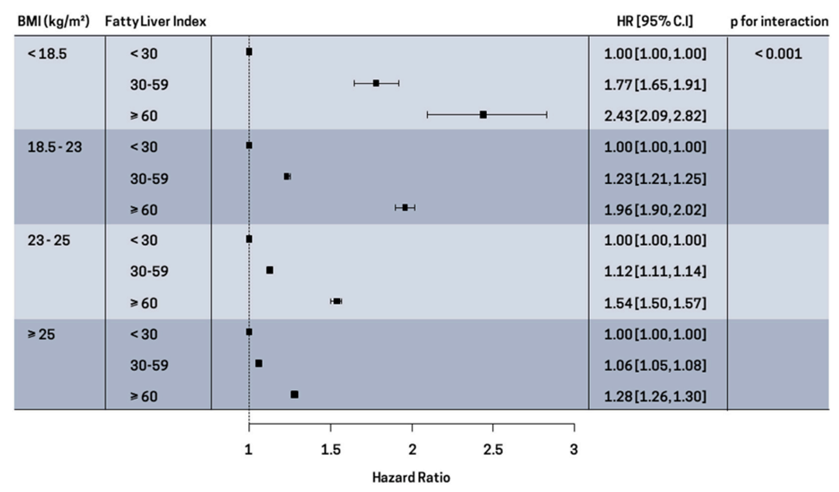Patients with non-alcoholic fatty liver disease have a 67% higher risk of death than the general population
- Fatty liver index is proportional to mortality... The risk of death greatly increases if the liver index is high when patients are underweight
- SNUH research team first identified the non-alcoholic fatty liver disease-mortality association through large-scale cohort analysis
It was found that the higher the 'fatty liver index(measure of non-alcoholic fatty liver disease)’, the higher the mortality rate. Furthermore, the lower the body weight, the higher the risk of death. It is expected that the prognosis of patients can be predicted by the fatty liver index.
On the 20th of September, the results of a nationwide cohort study, which was conducted by a joint research team led by Prof Yu Su Jong of Seoul National University Hospital and Prof Han Kyung-Do of Soongsil University, that analyzed the association between non-alcoholic fatty liver disease and mortality by cause were announced using the data of 8,858,421 people who participated in the 2009 national health examination.
Non-alcoholic fatty liver disease(NAFLD), which affects 1 in 4 people worldwide, is a condition in which a greater than normal amount of fat is accumulated in the liver even when not drinking. It is mainly accompanied by metabolic syndromes such as obesity, diabetes, and hyperlipidemia, and it can progress to hepatitis, liver cirrhosis, and fibrosis in 30% of patients.
According to previous studies, patients with NAFLD have a higher risk of death than normal people. However, most of the studies were conducted in the Western world and so their scope was limited. Therefore, the association between NAFLD and death in Asia has not yet been established.
The research team used the Fatty Liver Index (FLI) to analyze the correlation between NAFLD and death. This index is one of the most validated measures for identifying fatty liver disease and is calculated using body mass index, waist circumference, blood triglyceride level, and r-GTP level.
Based on this index, 8.85 million patients were followed up for 8.3 years, divided into low (FLI <30), medium (30 ≤ FLI <60), and high (FLI ≥60) groups. As a result, high FLI was found to correlate with higher risk of death.
When the variables were corrected, it was found that both mortality rates for each individual disease and for all the diseases studied - cardiovascular disease, cancer, respiratory disease, and liver disease - increased in proportion to the FLI.

[Graph 1] Effect of the fatty liver index(FLI) on overall and disease-specific mortality risk.
The risk of death increased linearly with the FLI. The overall risk of death was 19% higher in the middle index group and 67% higher in the high group compared to the low group. (Variables such as age, gender, smoking, drinking, BMI, waist circumference, etc. have been corrected for)
Next, the research team conducted a stratified analysis by dividing the study subjects into underweight, normal, overweight, and obese groups according to body mass index (BMI).

[Graph 2] Risk of death according to fatty liver index stratified by BMI. In all BMI groups, the risk of death increased according to the FLI. (Variables such as age, gender, smoking, drinking, BMI, waist circumference, etc. have been corrected for)
As a result, it was observed that the higher the FLI, the higher the risk of death in all BMI groups. Among them, the risk of death was even higher for those with a lower BMI alongside a high FLI. In other words, the worst prognosis of NAFLD was in the underweight group.
Based on these results, the research team explained that NAFLD patients should pay attention not only to commonly known metabolic syndromes such as obesity but also to diseases that cause weight loss (sarcopenia and sarcopenic obesity).
As a result of additionally analyzing the mortality rate by cancer type, it was confirmed that as the FLI increased, the mortality rate from esophageal cancer, stomach cancer, colorectal cancer, lung hepatobiliary cancer, breast cancer, and prostate cancer all increased linearly.
The research team emphasized that this study is significant as it comprehensively presented the association between NAFLD and mortality through an analysis based on the national population, that was not limited to a specific demographic.
Professor Yu Su Jong of the Department of Gastroenterology said, “This study was the first to identify the association between non-alcoholic fatty liver disease and death in the general population of Asia.” He followed this saying, "It seems that in the future we should pay attention to the clinical importance of fatty liver disease, which can affect the development of various diseases as well as mortality risks."
The results of this study were published online in the international journal ‘Metabolism clinical and experimental’.

[Pictures from left] Seoul National University Hospital Prof Yu Su Jong, SNUH Gangnam Centre Prof Chung Goh Eun, Seoul National University Medical School Prof Jeong Su-Min, and Soongsil University Prof Han Kyung-Do